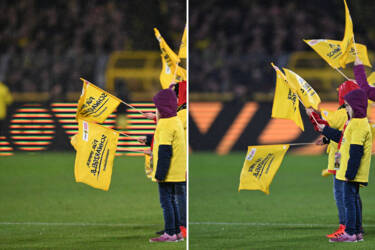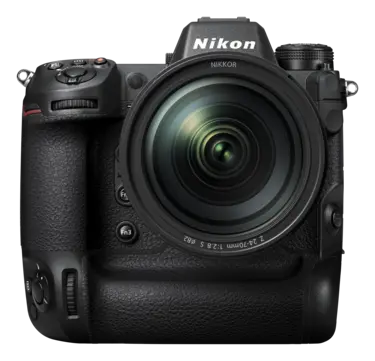Goodbye flicker

What is flicker reduction and how do you combat it? Nikon Ambassador Ina Fassbender explains the Z9 v5.0 firmware update
Flickering screens have long been the bane of photographers, especially sports photographers, whose images are often plagued with banding advertising boards, pulling attention away from the subject. Regardless of skill, it has been a problem faced by all, including widely published and multi-award-winning sports and news photographer, Ina Fassbender, who has been capturing everything from World Cups to the Olympics since 1989. But with the Nikon Z9 v.5.0 firmware update, and the introduction of flicker reduction technology, there is finally a cure for LED flicker. Here Ina shares her thoughts on its effectiveness and how you can get the most out of it.

Flicker reduction on. ©Ina Fassbender
What is LED Flicker and why is it a problem?
Ina Fassbender: LED flicker is the flashing of LED light bulbs on screens like those used as signboards and advertising banners. It is imperceptible to the human eye, as it happens too rapidly for us to see, but if you choose a shutter time that is too fast, you’ll catch the board with black bands running through the colour, which can really destroy your picture. The reason the light flickering becomes more obvious is because the camera’s frames per second (FPS) is not aligned with the frequency of the board’s electricity.
What is flicker reduction technology?
Flicker reduction is a revolution for mirrorless cameras! It allows photographers to fine-tune shutter speeds in small increments to minimise the banding from high-frequency LED lighting or screens, so that you achieve a much more consistent image quality.
How do you use it?
All you have to do is select a frequency preset that matches the frequency of the light source. Simply go to the shooting menu, find the high frequency flicker reduction and activate it. If necessary, select the fine adjustment of the shutter speed with the four stored presets, [PRE1] (7680 Hz) through [PRE4] (1920 Hz).
Once you have selected a frequency, you can only use shutter speeds that correspond to an integer multiple of the set frequency, so you can still adjust the shutter speed without losing the flicker reduction. In addition, you can customise the presets, save them, and switch between them depending on the situation. In some football stadiums I’ve been to, the boards have different frequencies, whereas in Dortmund, for example, all the boards use the same frequency. And because I’ve saved these frequencies as presets, I can choose what I need, when I need it. That really makes a big difference, it makes everything much easier.
Can you share your top tips for using flicker reduction?
The shutter speed should be faster than 1/(frequency) second. I always recommend taking test shots to find the shutter speed that minimises flicker and banding, as this takes a bit of trial and error and practice. The FPS also has a major influence on flicker. To get around this problem, the frame rate of your camera needs to match the frequency of the lights where you are. The frame rate should be divisible by the number of light pulses. Perhaps start with the auto system or choose one of the four default settings, adjust it until you find the point where the flicker stops, and then test it. You must always test it.
The auto system of the flicker prediction also works very well but, if you want to be certain, use a flicker metre or an app on your phone to find out what frequency rate you are dealing with, and then just dial it into the camera. Also storing my own presets has been really useful – it means I can save the settings for different stadiums I frequent.
What’s in your kitbag?
I have two Nikon Z9s and a Z8. Plus, NIKKOR Z 24-70mm f/2.8 S, NIKKOR Z 400mm f/2.8 TC VR S, NIKKOR Z 70-200mm f/2.8 VR S, NIKKOR Z 14-24mm f/2.8 S, NIKKOR Z 50mm f/1.2 S and a NIKKOR Z 26mm f/2.8. I also have a monopod, a chair and a 50cm transmission cable.
What advice would you give aspiring sports photographers?
The most important thing in sports photography is to understand the sport you are photographing. Know the main players and concentrate on them. Keep your focus on them and you will have a better chance of getting the best picture of those people.
Then look for the story, emotions and feelings. Try things. Be different. Try open apertures. Try long exposures. Sometimes you can get a great photo with a long exposure that gives you movement in the picture.
Also, find a good position, and look for the light. If you’re there for a long time, as with tennis, think about how the light will change over time. Sometimes, by the evening, you can get really incredible shadows.
Like a lot of things, experience makes it easier, so practise.
More in Gear
Featured products
More in Sports & Action

Unlock greater creativity









